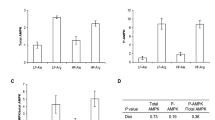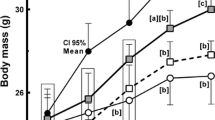Abstract
Dietary l-arginine (Arg) supplementation reduces white-fat gain in diet-induced obese rats but the underlying mechanisms are unknown. This study tested the hypothesis that Arg treatment affects expression of genes related to lipid metabolism in adipose tissue. Four-week-old male Sprague–Dawley rats were fed a low-fat (LF) or high-fat (HF) diet for 15 weeks. Thereafter, lean or obese rats continued to be fed their same respective diets and received drinking water containing 1.51% Arg–HCl or 2.55% l-alanine (isonitrogenous control). After 12 weeks of Arg supplementation, rats were euthanized to obtain retroperitoneal adipose tissue for analyzing global changes in gene expression by microarray. The results were confirmed by RT-PCR analysis. HF feeding decreased mRNA levels for lipogenic enzymes, AMP-activated protein kinase, glucose transporters, heme oxygenase 3, glutathione synthetase, superoxide dismutase 3, peroxiredoxin 5, glutathione peroxidase 3, and stress-induced protein, while increasing expression of carboxypeptidase-A, peroxisome proliferator activated receptor (PPAR)-α, caspase 2, caveolin 3, and diacylglycerol kinase. In contrast, Arg supplementation reduced mRNA levels for fatty acid binding protein 1, glycogenin, protein phosphates 1B, caspases 1 and 2, and hepatic lipase, but increased expression of PPARγ, heme oxygenase 3, glutathione synthetase, insulin-like growth factor II, sphingosine-1-phosphate receptor, and stress-induced protein. Biochemical analysis revealed oxidative stress in white adipose tissue of HF-fed rats, which was prevented by Arg supplementation. Collectively, these results indicate that HF diet and Arg supplementation differentially regulate gene expression to affect energy-substrate oxidation, redox state, fat accretion, and adipocyte differentiation in adipose tissue. Our findings provide a molecular mechanism to explain a beneficial effect of Arg on ameliorating diet-induced obesity in mammals.

Similar content being viewed by others
Abbreviations
- AA:
-
Amino acid
- AMPK:
-
AMP-activated protein kinase
- Arg:
-
l-Arginine
- DIO:
-
Diet-induced obese
- HF:
-
High fat
- HO-3:
-
Heme oxygenase 3
- LF:
-
Low fat
- NO:
-
Nitric oxide
- PGC1α:
-
PPARγ coactivator-1α
- PPARγ:
-
Peroxisome proliferator activator receptor γ
- RP:
-
Retroperitoneal
- RT-PCR:
-
Reverse transcriptase-polymerase chain reaction
- SCD1:
-
Stearoyl-CoA desaturase 1
- ZDF:
-
Zucker diabetic fatty
References
Bartesaghi S, Ferrer-Sueta G, Peluffo G et al (2007) Protein tyrosine nitration in hydrophilic and hydrophobic environments. Amino Acids 32:501–515
Bassit RA, Curi R, Costa Rosa LFBP (2008) Creatine supplementation reduces plasma levels of pro-inflammatory cytokines and PGE2 after a half-ironman competition. Amino Acids 35:425–431
Bray GA, Bellanger T (2006) Epidemiology, trends, and morbidities of obesity and the metabolic syndrome. Endocrine 29:109–117
Clark J, Palmer CJ, Shaw WN (1983) The diabetic Zucker fatty rat. Proc Soc Exp Biol Med 173:68–75
Dekaney CM, Wu G, Yin YL, Jaeger LA (2008) Regulation of ornithine aminotransferase gene expression and activity by all-trans retinoic acid in Caco-2 intestinal epithelial cells. J Nutr Biochem 19:674–681
Flynn NE, Bird JG, Guthrie AS (2008) Glucocorticoid regulation of amino acid and polyamine metabolism in the small intestine. Amino Acids. doi: 10.1007/s00726-008-0206-7
Frayn KN, Karpe F, Fielding BA et al (2003) Integrative physiology of human adipose tissue. Int J Obes 27:875–888
Fu WJ, Haynes TE, Kohli R et al (2005) Dietary l-arginine supplementation reduces fat mass in Zucker diabetic fatty rats. J Nutr 135:714–721
Fu WJ, Hu J, Spencer T et al (2006) Statistical models in assessing fold changes of gene expression in real-time RT-PCR experiments. Comput Biol Chem 30:21–26
Gualano B, Novaes RB, Artioli GG et al (2008) Effects of creatine supplementation on glucose tolerance and insulin sensitivity in sedentary healthy males undergoing aerobic training. Amino Acids 34:245–250
Guo GB, Xu CS (2008) Expression profiles of the organic acid metabolism-associated gene during rat liver regeneration. Amino Acids 34:597–604
Han J, Liu YL, Fan W et al. (2008) Dietary l-arginine supplementation alleviates immunosuppression induced by cyclophosphamide in weaned pigs. Amino Acids. doi: 10.1007/s00726-008-0184-9
He QH, Kong XF, Wu G et al. (2008) Metabolomic analysis of the response of growing pigs to dietary L-arginine supplementation. Amino Acids. 10.1007/s00726-008-0192-9
Higashida M, Xu S, Kojima-Yuasa A et al (2009) 1′-Acetoxychavicol acetate-induced cytotoxicity is accompanied by a rapid and drastic modulation of glutamine metabolism. Amino Acids 36:107–113
Hill JO, Peters JC, Catenacci VA, Wyatt HR (2008) International strategies to address obesity. Obesity Rev 9(Suppl 1):41–47
Hu CA, Khalil S, Zhaorigetu S et al (2008a) Human ∆1-pyrroline-5-carboxylate synthase: function and regulation. Amino Acids 35:665–672
Hu CA, Williams DB, Zhaorigetu S et al (2008b) Functional genomics and SNP analysis of human genes encoding proline metabolic enzymes. Amino Acids 35:655–664
Jobgen WS (2007) Dietary l-arginine supplementation reduces fat mass in diet-induced obese rats. Ph.D. Dissertation, Texas A&M University, College Station
Jobgen WS, Fried SK, Fu WJ et al (2006) Regulatory role for the arginine-nitric oxide pathway in metabolism of energy substrates. J Nutr Biochem 17:571–588
Jobgen W, Meininger CJ, Jobgen SC et al (2009) Dietary l-arginine supplementation reduces white-fat gain and enhances skeletal muscle and brown fat masses in diet-induced obese rats. J Nutr 139:230–237
Kersten S (2001) Mechanisms of nutritional and hormonal regulation of lipogenesis. EMBO Rep 2:282–286
Kim H (2008) DNA repair Ku proteins in gastric cancer cells and pancreatic acinar cells. Amino Acids 34:195–202
Kim S, Sohn I, Ahn JI et al (2004) Hepatic gene expression profiles in a long-term high-fat diet-induced obesity mouse model. Gene 340:99–109
Kohli R, Meininger CJ, Haynes TE et al (2004) Dietary l-arginine supplementation enhances endothelial nitric oxide synthesis in streptozotocin-induced diabetic rats. J Nutr 134:600–608
Li J, Yuan J (2008) Caspases in apoptosis and beyond. Oncogene 27:6194–6206
Li S, Zhang HY, Hu CC et al (2008a) Assessment of diet-induced obese rats as an obesity model by comparative functional genomics. Obesity (Silver Spring) 16:811–818
Li M, Kim DH, Tsenovoy PL et al (2008b) Treatment of obese diabetic mice with heme oxgenase induces visceral and subcutaneous adiposity, increases adiponectin levels, and improves insulin sensitivity and glucose tolerance. Diabetes 57:1526–1535
Liao XH, Majithia A, Huang XL, Kimmel AR (2008) Growth control via TOR kinase signaling, an intracellular sensor of amino acids and energy availability, with crosstalk potential to proline metabolism. Amino Acids 35:761–770
Lupi A, Tenni R, Rossi A et al (2008) Human prolidase and prolidase deficiency. Amino Acids 35:739–752
Ma XY, Lin YC, Jiang ZY et al. (2008) Dietary arginine supplementation enhances antioxidative capacity and improves meat quality of finishing pigs. Amino Acids. doi: 10.1007/s00726-008-0213-8
Maines MD (1997) The heme oxygenase system: a regulator of second messenger gases. Annu Rev Pharmacol Toxicol 37:517–554
Manna P, Sinha M, Sil PC (2008) Taurine plays a beneficial role against cadmium-induced oxidative renal dysfunction. Amino Acids. doi: 10.1007/s00726-008-0094-x
Marques MPM, Gil FPSC, Calheiros R et al (2008) Biological activity of antitumoural MGBG: the structural variable. Amino Acids 34:555–564
Montanez R, Rodriguez-Caso C, Sanchez-Jimenez F, Medina MA (2008) In silico analysis of arginine catabolism as a source of nitric oxide or polyamines in endothelial cells. Amino Acids 34:223–229
Muz B, Kontny E, Marcinkiewicz J et al (2008) Heme oxygenase-1 participates in the anti-inflammatory activity of taurine chloramines. Amino Acids 35:397–402
Nadler ST, Stoehr JP, Schueler KL et al (2000) The expression of adipogenic genes is decreased in obesity and diabetes mellitus. Proc Natl Acad Sci USA 97:11371–11376
Nisoli E, Clementi E, Paolucci C et al (2003) Mitochondrial biogenesis in mammals: the role of endogenous nitric oxide. Science 299:896–899
Olszanecki R, Kurnyta M, Biedron R et al (2008) The role of heme oxygenase-1 in down regulation of PGE2 production by taurine chloramines and taurine bromamine in J774.2 macrophages. Amino Acids 35:359–364
Orlando GF, Wolf G, Engelmann M (2008) Role of neuronal nitric oxide synthase in the regulation of the neuroendocrine stress response in rodents: insights from mutant mice. Amino Acids 35:17–27
Palii SS, Kays CE, Deval C et al (2008) Specificity of amino acid regulated gene expression: analysis of gene subjected to either complete or single amino acid deprivation. Amino Acids. doi: 10.1007/s00726-008-0199-2
Phang JM, Donald SP, Pandhare J, Liu YM (2008) The metabolism of proline, a stress substrate, modulates carcinogenic pathways. Amino Acids 35:681–690
Pohl J, Ring A, Ehehalt R et al (2004) New concepts of cellular fatty acid uptake: role of fatty acid transport proteins and of caveolae. Proc Nutr Soc 63:259–262
Ruderman N, Prentki M (2004) AMP kinase and malonyl-CoA: target for therapy of the metabolic syndrome. Nat Med 3:340–351
Shi W, Meininger CJ, Haynes TE et al (2004) Regulation of tetrahydrobiopterin synthesis and bioavailability in endothelial cells. Cell Biochem Biophys 41:415–433
Sotgia S, Zinellu A, Pinna GA et al (2008) A new selective pre-column ninhydrin-based derivatization for a RP-HPLC determination of plasma asymmetric dimethyl-l-arginine (ADMA) by fluorescence detection. Amino Acids 34:677–682
Suenaga R, Yamane H, Tomonaga S et al (2008) Central l-arginine reduced stress responses are mediated by l-ornithine in neonatal chicks. Amino Acids 35:107–113
Tan BE, Yin YL, Liu ZQ et al (2008) Dietary l-arginine supplementation increases muscle gain and reduces body fat mass in growing-finishing pigs. Amino Acids. doi:10.1007/s00726-008-0148-0
Trostchansky A, Rubbo H (2007) Lipid nitration and formation of lipid-protein adducts: biological insights. Amino Acids 32:517–522
Voss P, Grune T (2007) The nuclear proteasome and the degradation of oxidatively damaged proteins. Amino Acids 32:527–534
Wang JT (2007) Polyamines and mRNA stability in regulation of intestinal mucosal growth. Amino Acids 33:241–252
Wang WW, Qiao SY, Li DF (2008a) Amino acids and gut function. Amino Acids. doi: 10.1007/s00726-008-0152-4
Wang JJ, Wu G, Zhou HJ, Wang FL (2008b) Emerging technologies for amino acid nutrition research in the post-genome era. Amino Acids. doi:10.1007/s00726-008-0193-8
Willoughby DS, Stout JR, Wilborn CD (2007) Effects of resistance training and protein plus amino acid supplementation on muscle anabolism, mass, and strength. Amino Acids 32:467–477
Wu G, Meininger CJ (2009) Nitric oxide and vascular insulin resistance. BioFactors. dio: 10.1002/BIOF.00004
Wu G, Morris SM Jr (1998) Arginine metabolism: nitric oxide and beyond. Biochem J 336:1–17
Wu G, Fang YZ, Yang S et al (2004) Glutathione metabolism and its implications for health. J Nutr 134:489–492
Wu G, Bazer FW, Davis TA et al (2007a) Important roles for the arginine family of amino acids in swine nutrition and production. Livest Sci 112:8–22
Wu G, Bazer FW, Cudd TA et al (2007b) Pharmacokinetics and safety of arginine supplementation in animals. J Nutr 137:1673S–1680S
Wu G, Collins JK, Perkins-Veazie P et al (2007c) Dietary supplementation with watermelon pomace juice enhances arginine availability and ameliorates the metabolic syndrome in Zucker diabetic fatty rats. J Nutr 137:2680–2685
Wu G, Bazer FW, Datta S et al (2008a) Proline metabolism in the conceptus: implications for fetal growth and development. Amino Acids 35:691–702
Wu G, Bazer FW, Davis TA et al (2008b) Arginine metabolism and nutrition in growth, health and disease. Amino Acids. doi: 10.1007/s00726-008-0210-y
Yan H, Aziz E, Shillabeer G et al (2002) Nitric oxide promotes differentiation of rat white preadipocytes in culture. J Lipid Res 43:2123–2129
Yoon JC, Chickering TW, Rosen ED et al (2000) Peroxisome proliferator-activated receptor gamma target gene encoding a novel angiopoietin-related protein associated with adipose differentiation. Mol Cell Biol 20:5343–5349
Zou CH, Shao JH (2008) Role of adipocytokines in obesity-associated insulin resistance. J Nutr Biochem 19:277–286
Acknowledgments
We thank Dr. Laurie Davidson and Mr. Scott Jobgen for technical assistance. This work was supported by National Research Initiative Competitive Grants from the USDA Cooperative State Research, Education, and Extension Service (2008-35206-18762), American Heart Association-TX (0655109Y and 0755024Y), and Texas AgriLife Research (H-8200).
Author information
Authors and Affiliations
Corresponding author
Rights and permissions
About this article
Cite this article
Jobgen, W., Fu, W.J., Gao, H. et al. High fat feeding and dietary l-arginine supplementation differentially regulate gene expression in rat white adipose tissue. Amino Acids 37, 187–198 (2009). https://doi.org/10.1007/s00726-009-0246-7
Received:
Accepted:
Published:
Issue Date:
DOI: https://doi.org/10.1007/s00726-009-0246-7




